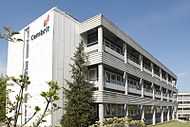Cembrit
 | |
| Industry | Construction industry |
|---|---|
| Founded | 1927 |
| Headquarters | Aalborg, Denmark |
| Key people | Jørgen N. Jacobsen(CEO), Bjarne Moltke Hansen (Chairman of the board) |
| Products |
All products are in fibre cement: Flat sheets for exterior and interior cladding Slates for roofing and facing Corrugated sheets for roofing and facing |
| Revenue | €196,24 million (2011) €185,64 million (2010)[1] |
| Profit | EBIT €7,26 million (2011) EBIT €3,52 million (2010)[1]FLSmidth Annual Report 2011 |
| Employees | 1200 (September 2011) |
| Website | www.cembrit.com |
Cembrit is one of the distributors and manufacturers of fibre-cement products in Europe and offers a range of fibre-cement based products for roofing, interior cladding and exterior cladding. [2]
Besides delivering building materials, Cembrit provides installation for residential houses, holiday cottages, trade and industry buildings, agricultural buildings, shops and offices as well as public buildings – in both new build and renovation projects.
Cembrit employs approximately 1200 people situated in more than 20 European countries and have distributors worldwide. Cembrit holds factories in Finland, the Czech Republic, Poland, Italy and Hungary. Cembrit is owned by the FLSmidth Group.

Product development is handled by the Cembrit R&D department situated in Aalborg. In 2009, Cembrit launched a new extensive product range within cladding, and in 2011, Cembrit launched a new "invisible" fixing system called Cembrit Flow System. Flow
History
In 1910, the Russian tsar placed an order for three fibre-cement plants with the Danish company FLSmidth & Co. Unfortunately for the tsar, the 1917 revolution had broken out by the time his plants were finally ready to ship.[3] with the aim of expanding their business into the fibre-cement category.
One of these packaged plants was almost forgotten by time and spent the next 13 years in storage, until FLSmidth & Co. dug it out and founded its own fibre-cement subsidiary, Dansk Eternit-Fabrik - now Cembrit - in the city of Aalborg.
The plant that never made it to the tsar’s Russia became the foundation for Dansk Eternit-Fabrik in 1927. Over the next 50 years, Dansk-Eternit Fabrik grew and expanded and in the late 1970s, the company really started to increase its export activities. For three decades, Dansk-Eternit Fabrik expanded through a number of acquisitions of other fibre-cement manufactures and distributors across Europe.
In 1938, the brand name "Cembrit" was applied for the first time in the company as a sub-brand for the then small export activities. [4]
At that time, the group had not yet expanded and consisted merely of one Danish company situated in Aalborg. The name ‘Cembrit’ derives from the Cimbri – a nomadic tribe from Northern Denmark that conquered large parts of Europe and threatened the Roman Empire around 100 BC. It was first used in 1941 as the name of an export brand during Dansk Eternit-Fabrik’s European conquest.
As the Cembrit group continued to grow, an increasing demand for a shared corporate identity arose. Therefore, the company changed corporate name and name of all subsidiaries to Cembrit – Cembrit hereby changed from being a sub-brand to being the corporate company name.
Today, Cembrit consists of the parent company, Cembrit Holding A/S, and the subsidiaries situated in more than twenty countries across Europe.[citation needed]
References
- ↑ 1.0 1.1 FLSmidth Annual Report 2011 "FLSmidth Annual Report 2011". Retrieved 2012-08-23.
- ↑ "Cembrit help for princess elizabeth hospital". Building talk. Retrieved 2009-12-05.
- ↑ "FLSMIDTH – buy". Jyske Bank. Retrieved 2009-12-04.
- ↑ "The business case in emerging markets". www.Sustainability.com. Retrieved 2009-12-04.
External links
| ||||||||||||||||||||||||||